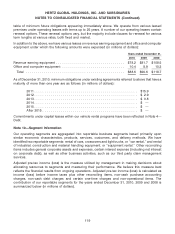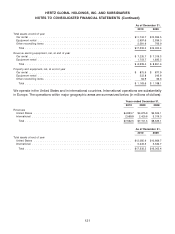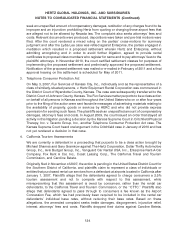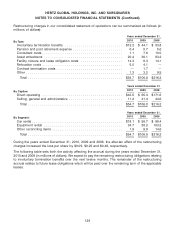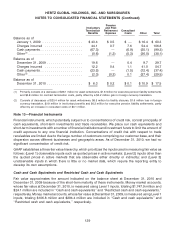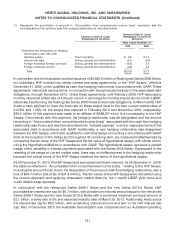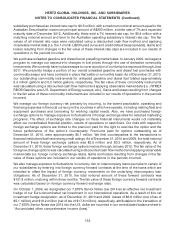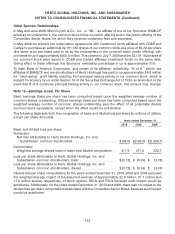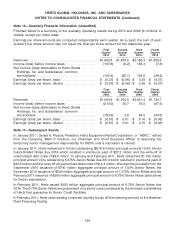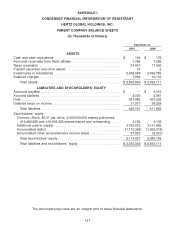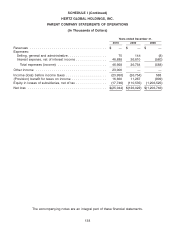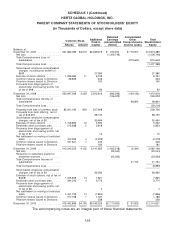Hertz 2010 Annual Report Download - page 153
Download and view the complete annual report
Please find page 153 of the 2010 Hertz annual report below. You can navigate through the pages in the report by either clicking on the pages listed below, or by using the keyword search tool below to find specific information within the annual report.
HERTZ GLOBAL HOLDINGS, INC. AND SUBSIDIARIES
NOTES TO CONSOLIDATED FINANCIAL STATEMENTS (Continued)
Pension
Involuntary and Post
Termination Retirement Consultant
Benefits Expense Costs Other Total
Balance as of
January 1, 2009 .................... $43.4 $ 0.5 $ — $ 16.4 $ 60.3
Charges incurred ................... 44.1 0.7 7.6 54.4 106.8
Cash payments ..................... (67.3) — (6.9) (25.1) (99.3)
Other(1) ........................... (0.6) (1.2) (0.3) (36.0) (38.1)
Balance as of
December 31, 2009 .................. 19.6 — 0.4 9.7 29.7
Charges incurred ................... 12.2 0.4 1.1 41.0 54.7
Cash payments ..................... (23.5) — (1.5) (12.4) (37.4)
Other(2) ........................... (2.0) (0.2) 0.1 (27.4) (29.5)
Balance as of
December 31, 2010 .................. $ 6.3 $0.2 $0.1 $10.9 $ 17.5
(1) Primarily consists of a decrease of $36.1 million for asset writedowns, $1.6 million for executive pension liability settlements
and $0.8 million for contract termination costs, partly offset by a $0.2 million gain in foreign currency translation.
(2) Consists of decreases of $20.4 million for asset writedowns, $6.5 million for facility closures, $1.6 million loss in foreign
currency translation, $0.9 million in involuntary benefits and $0.2 million for executive pension liability settlements, partly
offset by an increase in consultant costs of $0.1 million.
Note 13—Financial Instruments
Financial instruments, which potentially subject us to concentrations of credit risk, consist principally of
cash equivalents, short-term investments and trade receivables. We place our cash equivalents and
short-term investments with a number of financial institutions and investment funds to limit the amount of
credit exposure to any one financial institution. Concentrations of credit risk with respect to trade
receivables are limited due to the large number of customers comprising our customer base, and their
dispersion across different businesses and geographic areas. As of December 31, 2010, we had no
significant concentration of credit risk.
GAAP establishes a three-tier value hierarchy, which prioritizes the inputs used in measuring fair value as
follows: (Level 1) observable inputs such as quoted prices in active markets; (Level 2) inputs other than
the quoted prices in active markets that are observable either directly or indirectly; and (Level 3)
unobservable inputs in which there is little or no market data, which require the reporting entity to
develop its own assumptions.
Cash and Cash Equivalents and Restricted Cash and Cash Equivalents
Fair value approximates the amount indicated on the balance sheet at December 31, 2010 and
December 31, 2009 because of the short-term maturity of these instruments. Money market accounts,
whose fair value at December 31, 2010, is measured using Level 1 inputs, totaling $1,747.9 million and
$24.1 million are included in ‘‘Cash and cash equivalents’’ and ‘‘Restricted cash and cash equivalents,’’
respectively. Money market accounts, whose fair value at December 31, 2009, is measured using Level 1
inputs, totaling $106.8 million and $294.4 million are included in ‘‘Cash and cash equivalents’’ and
‘‘Restricted cash and cash equivalents,’’ respectively.
129


